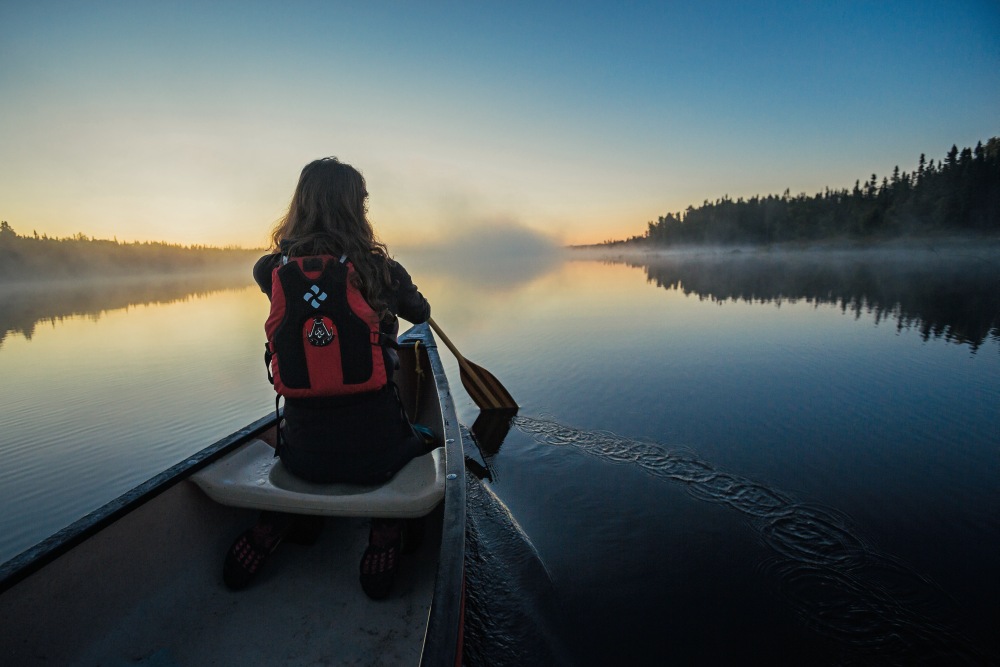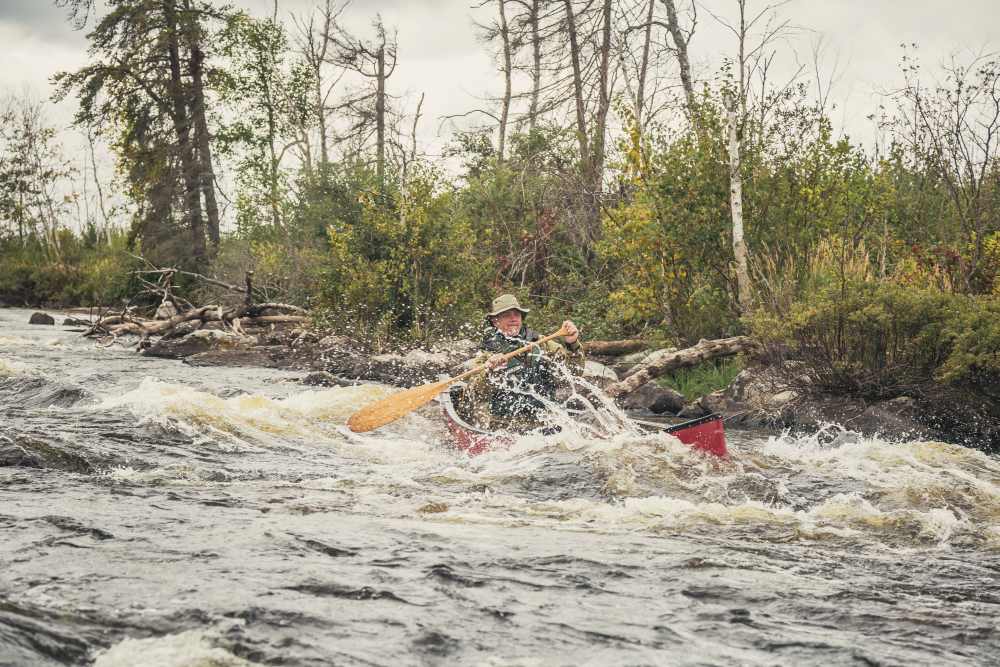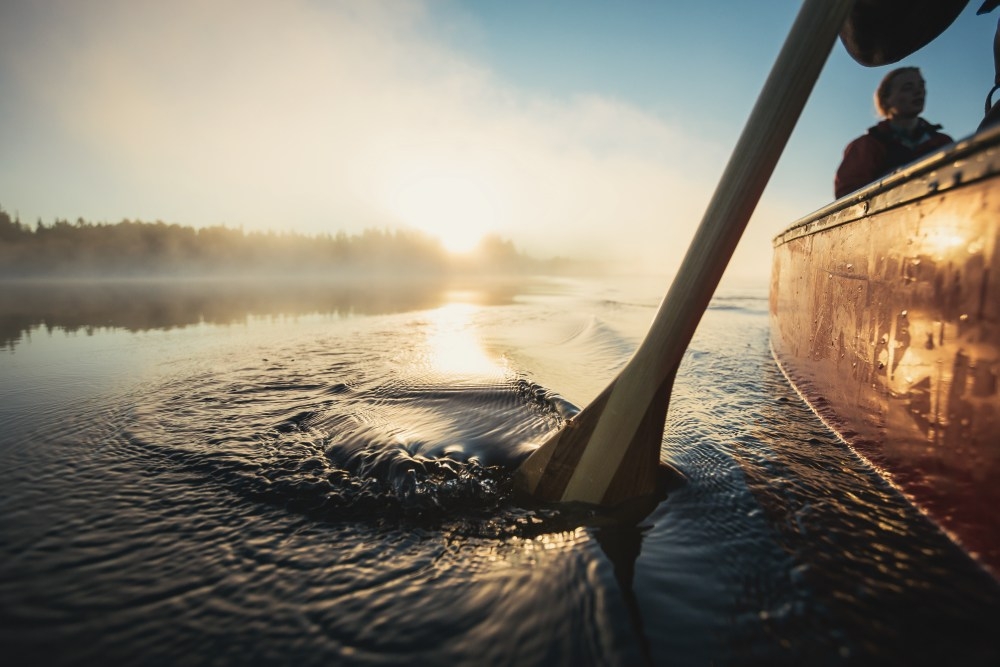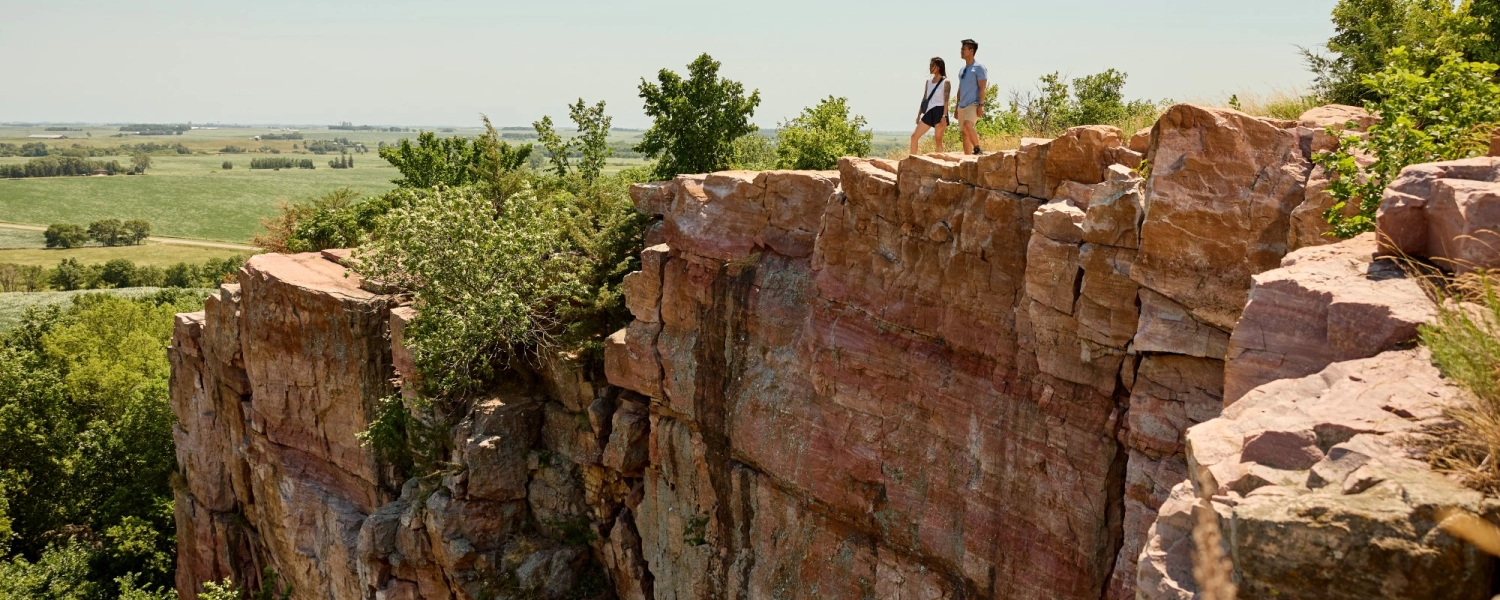- Details
- Written by: Mike Walker
"Need any help?”
It seems very strange to have Ray Mears in my room as I pack for a canoe expedition adventure, deep into Ontario’s Wabakimi Provincial Park, yet what seems even stranger is my answer.
“No! I think I’m okay thanks,” as I’m sure there’s a multitude of things I can learn from this wilderness legend!
Not perturbed by my answer, Ray spots my knife. Picking it up, he nods slowly, weighing it in his palm, giving it a sign of approval.
“This is the knife I use.” Ray passes me a surprisingly heavy, razor sharp, antler-handled knife. I can’t help thinking of Crocodile Dundee and his line “That’s not a knife. This a knife!” as he pulls a huge hunting knife on a New York mugger.
“I give one of these knives to each of the guides who work for me. I say it’s to remind them of the weight of responsibility they’re taking on.”
A knife like that would hang heavy around most people’s waists, but not Ray’s. He exudes a comfort in his gear and surroundings which can only come with experience. In a city, such confidence and self-belief could be misconstrued as arrogance; celebrity aloofness even. Yet later, as our small group journeys deeper into the boreal forest, I begin to understand that couldn’t be further from the truth. Ray has an inner calmness, which is a joy to be around. He only disturbs the constant noise of nature – only truly noticed when you stop and listen for it – to pass on a gem of knowledge, or to offer encouragement.
Dancing with wolves
My journey of discovering the forests of Ontario’s far north, and its inhabitants, actually started a few days before meeting Ray in the gateway city of Thunder Bay.
The central Canadian harbour on the shores of Lake Superior is where historically fur-traders would have shipped beaver pelts south to Toronto, and then beyond, to the markets of Europe. Today Thunder Bay is reinventing itself as a gateway to epic adventures like the one I’m taking with Ray Mears in the far north of this vast province.
I had arrived into Thunder Bay, via Toronto, with a few days to spare; so after an exhilarating sail on Lake Superior, in wind strong enough to blow away the cobwebs of a trans-Atlantic flight, I took the short drive to Sleeping Giant Provincial Park.
The park – colloquially known as ‘The Giant’ – is a slim peninsula of forested land which protrudes into Lake Superior. With over 100 kilometres of hiking and multi-use trails to explore, a mountain bike was the perfect way to do it.
While it’s possible to see The Giant from the city of Thunder Bay, as soon as I left the parking lot at the Park Headquarters, I realised it was a world away from the urban centre less than an hour’s drive away.
I rode alone though a dense forest of birch and aspen, on rough, yet well-maintained trails, often splashing through small streams and large puddles, until I arrived at the Head Trail.
Leaving my bike by a still-smoking fire pit at one of the many ‘hike to’ campsites, I set off up the steep trail to ‘The Head’ peak. The Head is a table-top mountain of sedimentary rock, with great views across to the ‘Top of the Giant’, the main mountain in the park.
Returning down the same path, I was soon back at my bike, but as I was climbing back into the saddle something caught my eye.
Behind the thin strip of vegetation that separated me from the water’s edge a large dog – at least, that’s what I assumed it must be – strolled along the shore without even glancing my way. I told myself it was the pet of the people who had started the fire, and who had presumably camped here the previous night, even if I hadn’t actually seen anyone since leaving the park office.
Without giving the ‘dog’ a second thought, I set off on a trail taking me south, when suddenly I saw a large shape cross the path a short distance in front of me. A wolf! It was unmistakably a wolf, and as I realised this, my heart started to race. While seeing a wolf in the wild was fulfilling a life-long dream, I couldn’t help but ask myself, “Don’t they normally travel in packs?”
Quickly looking around me, I could see nothing, yet still I could almost feel hundreds of imaginary eyes boring into my very soul. The one wolf I could see had retreated around six feet into the forest, turning its head to look straight at me.
Now, I’m no Doctor Doolittle, but for some reason I felt at ease; the wolf’s actions and expressions calmed me. I felt no threat from this wild creature, and after what felt like a spiritual connection, it turned and was lost to me in the late afternoon shade of the forest.
As I rode back to civilisation I wondered if the ‘large dog’ I had seen earlier within striking distance by the lake, had actually been a wolf too.
Northern exposure
The wolf encounter was the perfect start to my Canadian adventure, and now I’m heading north with Ray, knives safely sheathed, 1 ½ hours to Armstrong.
Driving through the dense boreal forest, we see only a handful of cars – the only delay caused by a black bear stubbornly lolloping across the road, before crashing into – and through – the roadside bushes.
Eventually, the highway simply finishes aside the railway tracks of Armstrong, a tiny settlement on the Trans Canadian Railway and our jumping off spot into the wilderness proper. From here, there’s nothing man-made of note north of the railway line at Armstrong, until you pass the north pole and head a long way back south into Russia.
After a quick visit to the time capsule of the local frontier shop, which sells everything from hunting paraphernalia to children’s toys, we unload our gear at the Wabakimi Eco Lodge. The lodge is owned by Bruce Hyer, the organiser of our little group, as well as a member of the Canadian parliament for the Green party.
Bruce dropped out of mainstream Canadian life in the 70’s to live deep in the Wabakimi boreal forest. It was this period of wild living which instigated his idea of creating a protected area within Ontario’s wild north. Through direct lobbying of the province, Bruce’s dream ultimately became the staggeringly huge, 5 million acre plus Wabakimi Provincial Park that exists today.
It’s probably the largest canoe-able reserve anywhere in the world. But what’s even more staggering is that, despite its relative ease of access, Wabakimi sees less than 1,000 visitors a year. Your chance of meeting another human while journeying here isn’t even slim.
Waking to a clear and cold autumn morning, we leave the comfort of the lodge, to wait – with childlike excitement – on a small jetty for a float-plane to arrive. Our small group consists of Ray Mears, Becky Mason (canoe expert, artist and daughter of environmental film maker Bill Mason), Bruce Hyer and his son. It feels like a pretty exclusive ‘recce’ group but perfect to scope out a route for Ray to take with the lucky winners of a competition being put on by the Ontario Tourist Board.
Soon our conversation, and last minute checking of kit, is interrupted by the appearance of a 1950’s Otter float plane. Almost skimming the tree tops, it glides downwards in near silence as the pilot cuts the revs, before its large aluminium floats slice into the clear calm water. Our relaxed waiting suddenly turns to beaver-like activity, as we load the bags into the Otter’s interior, and the pilot straps our canoes to the float stanchions.
“Quick, quick, time is money when hiring one of these planes,” encourages Bruce.
We heed his words and with surprising speed, we’re airborne and flying parallel to the Trans Canadian Railway Line.
It’s only from such an elevated vantage point that it’s possible to really grasp the scale of our surroundings. The boreal forest stretches away to our east and west, seemingly broken only by glittering lakes, as it seems to wrap around the world from horizon to horizon.
Our short flight ends with a sharply banked turn and a short bumpy glide into a headwind, before a very smooth touchdown on the Allen Water River. We taxi over to a small jetty, where we load our kit from plane to canoe, as a mink scuttles along the shore line.
I jump in with Becky Mason, who within moments realises my lack of skill, and instructs me in a ‘first nation’ paddle stroke, called a punch stroke: She shows me how to throw a short jab punch with my hand on the paddle’s t-grip, finishing the stroke with a slight trunk rotation. I appreciate her expert knowledge as I eventually fall into a steady rhythm, while she tells me of how the 17th century voyageurs – fur traders, mainly from Scotland and France – learnt from the first nation hunters the skills needed to navigate the forest’s waterways.

There’s no real noticeable current to the water, and if I didn’t know better I’d think we were on a lake. Ray Mears, paddling alone, hugs the shore line so as to keep out of the slight breeze that’s blowing across a wide section on the Allen Water River. He stops among some reeds and as we glide alongside he informs us, “You can eat the roots of these. They’re a bit tough and fibrous, but they’ll keep you alive.”
Passing on the opportunity of a bush snack, we paddle on before stopping on a rocky outcrop a few hours before sunset. Rather than erect my own tent, I sit and marvel at the speed and skill of Ray’s well-practised routine.
First he ties a tarp/bivvy sheet between some trees to protect his kit from the elements. Then he starts a fire with kindling gathered from the shore edge. Sparks from a single stroke of his knife down a fire stick, worn on a piece of green twine around his neck, ignite a scraped piece of birch bark.
See the wood for the trees
Seeing my inactivity, Ray asks me to collect some fire wood. Now: finding fire wood in an almost endless forest should be an easy task. And not wanting to look like a bush-craft idiot on my first assignment from Ray, I delve deeper into the woods.
Being a Provincial Park you’re not allowed to cut any green wood, so I have to collect from the floor. I start to panic as nearly every piece I pick up is rotten and will never burn. Eventually I return with an armful of wood, which thankfully passes Ray’s approval.
By this time the fire is already well established, and Ray is putting the finishing touches to a tripod which he’s constructed from three long branches. It’s tied together near the top with a thin flexible stick, from which he hangs a kettle.

Lastly he erects a single-man tent – single so as to be small, lightweight and easier to keep warm in than a larger two-person tent. By the time he’s done this, the water has started to boil over into the flames.
“Tea’s ready, help yourself,” he offers.
We eat a dinner of rice and burgers, around the camp fire. Our conversation is accompanied by the gentle sound of lapping water, as the first of the evening’s countless stars begin to show themselves – there’s certainly no light pollution here.
“I love being out here,” states Ray. “It’s as if we’re journeying in the footsteps of the voyageurs of old; they were the real pioneers of modern day Canada. I simply can’t understand why there’s a maple leaf on the Canadian flag – it should be a canoe!”
With the chill of the night setting in, we retire to our tents, ready for an early start.
I awake the next morning to a lone loon’s call, hauntingly breaking the morning’s silence, only to find, as I emerge from my tent that Ray is up already, with the fire rekindled and the kettle on over the flames, having a shave at the water’s edge.
As the tea warms our insides, a golden eagle circles above us on the morning thermals, and we pick up last night’s conversation, as if uninterrupted.
“When I travel into the boreal forest of Ontario,” continues Ray, “I don’t simply see it as passing through woodland. To me it’s more than that; it’s as if I’m entering a living organism.” Ray shifts a tripod leg without breaking his chain of thought, expertly shifting the refilled kettle back over the flames. “It doesn’t take me long to feel a part of the forest again. There’s an inner silence here which is lost to us in the modern world. Coming here is a cleansing experience for me, where you can leave modern day trappings behind and simply listen to the forest and your inner voice. It’s something most of us seldom find the time to do.”
Beaver patrol
We break camp after a breakfast of eggs and ham, and are soon on the water again. It’s easy to slip back into a relaxed, almost meditative state of repetitive movement, as our paddles and canoes cut through the mirror-like surface of the river.
I think back to a dinner in Thunder Bay, when the manager of Wabakimi Provincial Park had told me how they’d taken advice from the area’s first nation residents, on how to evaluate the health of the park’s animals.
“They told us to just look at the beavers. Beavers are an indicator species; if they’re doing well, then the park’s doing well. It’s simple really – when the water’s clean, the plants will grow well, and if the plants grow well the beavers have food, as do all the other animals. So by studying one species, we can assess the health of the whole park.”
As we glide down the now narrowing and quickening river, I reflect on the fact that we can still learn a lot, both personally and globally, from the old knowledge of a people who still live amongst nature.
My relaxed state is disturbed by an approaching rapid, which we stop above, and inspect on foot. Becky tells me that “In such a wild location, if I think it’s big enough that I need to wear a helmet, I portage.” Portage means to carry all the equipment and boats around the rapid, and so is something to be avoided if at all possible!
Becky and Ray agree that it looks okay, so one boat at a time – with someone on shore holding a throw line, just in case – we run the rapid. It’s an adrenaline-fuelled moment, and I get a face-full of water as the first wave strikes the boat. Safely through, we have to take all the kit out of the boat anyway to empty the water out, but the fun is worth it.

Our last night is spent beside the Trans Canadian Railway line at the tiny settlement of Allen Water Bridge. Today this place is nothing more than a few fishing lodges, but amazingly – with a little pre-organization – you can get the massive 4,466 km cross-Canada train to stop and pick you up.
It is a bizarre, almost surreal experience to load our canoes aboard the flagged-down diesel-powered beast. One minute we’re in the wild, feeling that connection to the forest that Ray talked of; the next we’re in a world of holiday-makers watching films on iPads and making mobile phone calls.
I stare out the train window, suddenly detached from the forest landscape we’re speeding through. I long to pull the emergency cord, grab my canoe, and dive back into the forest to regain my inner voice.
For a chance to win this adventure, go to adventure.travelontario.co.uk




